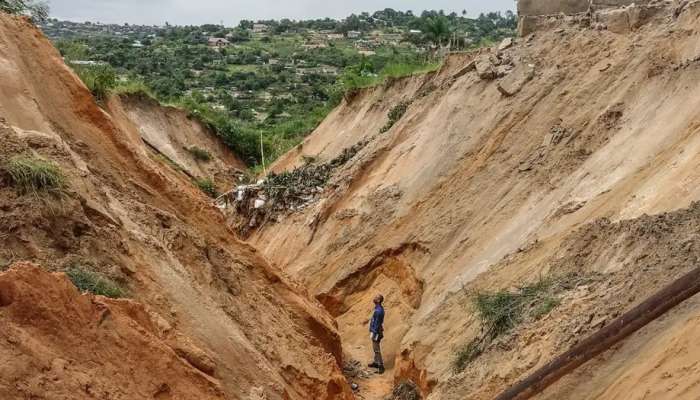
Kinshasa: Gigantic urban gullies stretch like scars across cities in the Democratic Republic of Congo. A study published by an international group of researchers
in August maps these trenches across the DRC for the first time — finding almost 3,000 of them.
The scale of the threat is striking. From 2004 through 2023, almost 120,000 people are estimated to have been displaced by urban gullies in the DRC. Scientists warn that hundreds of thousands more could lose their homes in the next decade. With millions of people currently living in potential hazard zones, understanding gullies is crucial.
What are gullies?
Gullies are an extreme form of erosion. These huge channels are carved by water and can stretch dozens of meters wide and hundreds of meters long. In cities, they are a looming threat that eventually swallows houses, businesses and other infrastructure, such as roads and railways.
To track them, researchers combined population densities with satellite images, cross-checking against aerial photographs from the 1950s. They found that more than half of the cities investigated are affected. In almost all cases, gullies have expanded in the past decade.
How do gullies form?
Both natural and human-made factors drive gully formation. In the DRC, intense rainfall and erodible soils combine with rapid urbanization and inadequate urban planning, turning water into destructive flows.
"The main underlying causes appear to be deficiencies and gaps in urban planning and land-use management," said Guy Ilombe Mawe, study author and a researcher at the University of Bukavu. The DRC's rapid urban growth has left communities without sufficient drainage systems.
Kinshasa, Africa's third-biggest metropolis, is especially hard-hit, with more than 800 gullies. In 1950, it had just 200,000 residents. Today, nearly 18 million people live there.
"Congo is one of the countries that is urbanizing at an extremely rapid rate," Matthias Vanmaercke, a study author from KU Leuven in Belgium, told DW. "A lot of this urbanisation is unplanned, rather chaotic," Vanmaercke said. "If people build houses," he added, "this is usually without proper infrastructure to capture the water."
With urbanization comes deforestation. Rooftops, roads and other sealed surfaces replace plants. This leaves less land able to absorb water. The study found that 98% of urban gullies are linked to local road networks.
Gullies often occur in areas with sandy soils that erode easily. Heavy rainfalls also have an influence and can expand already formed gullies. With climate change expected to bring increased rainfall, scientists warn that the risk is only growing.
Are gullies the same as landslides?
Not quite. While both are destructive, landslides and gullies have some key differences. Gullies are typically found at the edges of plateaus with sandy soils, whereas landslides often occur in steep hilly areas with clay-based soils.
Both can be unpredictable. But there's a crucial difference — once a gully forms, it is permanent and grows with each heavy rainfall. That makes them especially dangerous in cities, where homes are constantly under threat.
"Gullies, they can form very rapidly, within one rainfall event, and then this is often very dangerous because people don't expect it, and suddenly there's this huge gap destroying their house." Vanmaercke said. "But what also happens is that, once a gully is there, it stays there and then you have this huge gap in which new water can run every time there is a rainfall event."
Advertisement
"People living at the edge always become a little bit more threatened 1 meter at a time," Vanmaercke said. The proximity to gullies takes a psychological toll, he said, as people stay awake in their home "every night that it rains, just hoping it will not be destroyed."
Can gullies be predicted?
No, not yet, at least. Scientists say predicting when or where a gully might appear or widen is difficult, but crucial in preventing further destruction.
Researchers are working toward a better understanding of how gullies are formed and seeking solutions.
"One of the things we want to achieve is to develop early warning systems and ... send out warnings like: 'Tonight will be really dangerous, try and find shelter elsewhere,'" Vanmaercke said.
What can be done?
Stabilizing gullies is expensive — fixing just one can cost over $1 million (€920,000). That leaves local communities to act on their own.
"There are local community initiatives aimed at trying to stabilize gully expansion," Mawe said. These include "planting bamboo and other vegetation to stabilize the soil, placing sandbags at the gully head, and digging pits or sometimes installing water tanks within plots to store runoff water."
But, Mawe said, these efforts often fall short and are not effective in stopping gully expansion.
"I think the most worrying and concerning thing: Once you live next to a gully, you basically become trapped ... because also the land value drops dramatically," Vanmaercke said.
The most effective step, the researchers said, is to reduce the amount of water flowing into gullies in the first place.
For people living on the edge of a gully, every heavy rain brings the risk of losing their homes.